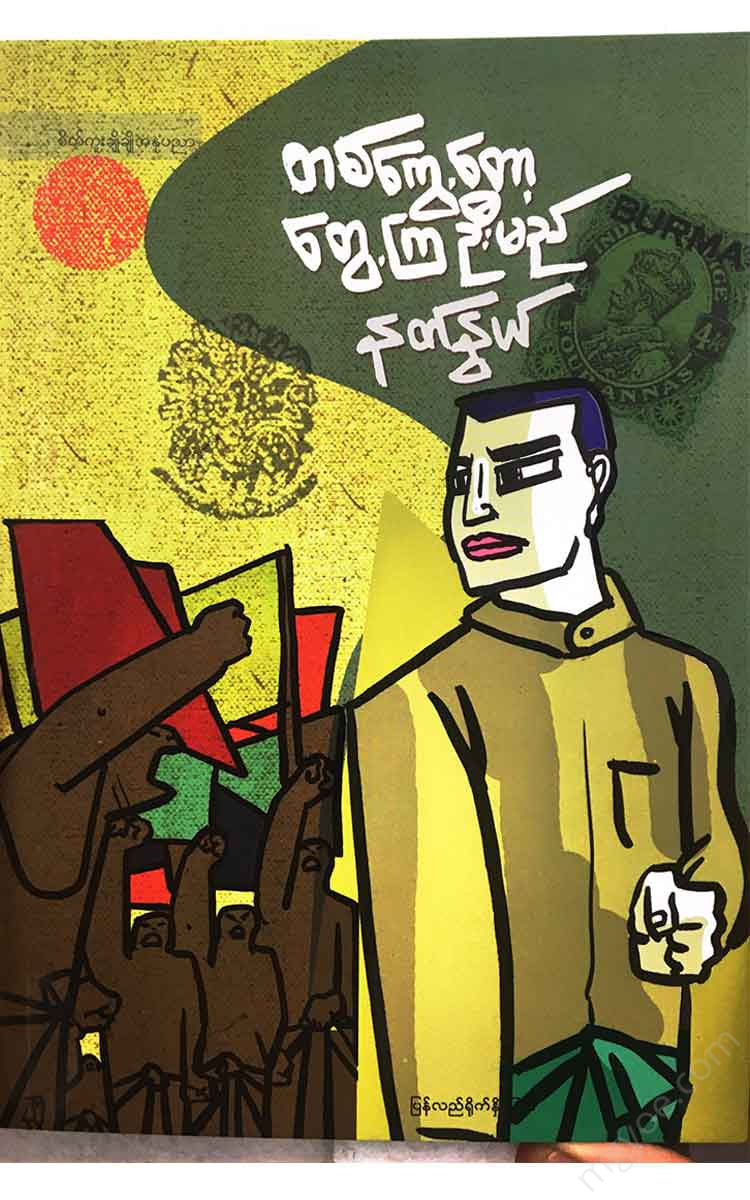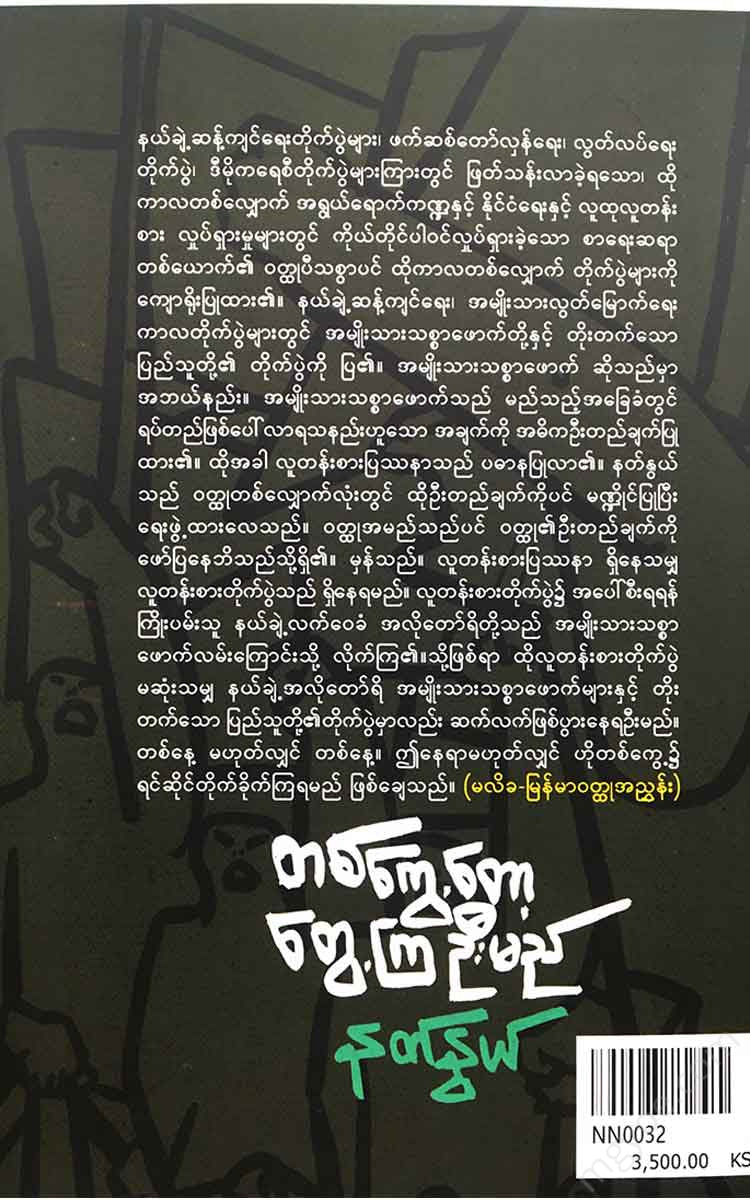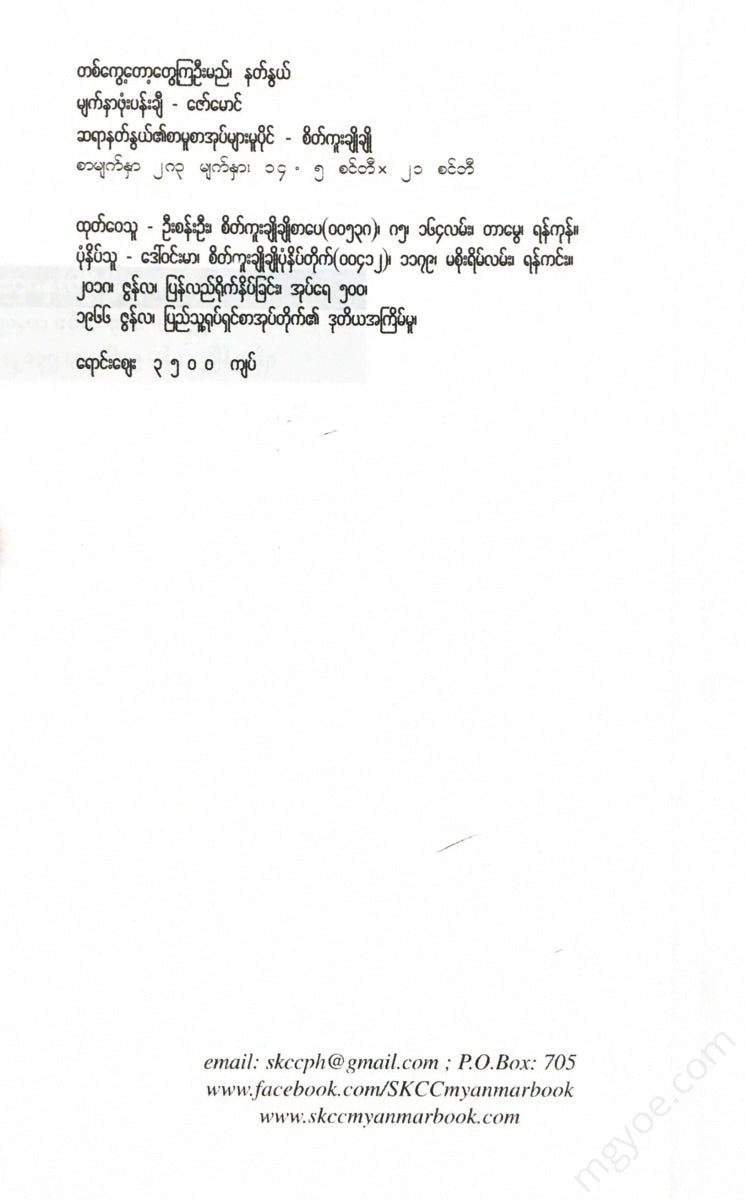စိတ်ကူးချိုချိုစာပေ
Nat Nwe - We'll see you in a moment.
Nat Nwe - We'll see you in a moment.
Couldn't load pickup availability
As midnight approached.
The entire city of Myitkyina, the entire neighborhood of Ramapura, the entire length of Kyunpintha Road, and the entire area around the three-way intersection were dark, silent, and devoid of pedestrians.
Only four people are using the night of the waning moon to carry out a secret plan, working tirelessly and meticulously.
It's a grand plan to not only violate existing laws, but also to uproot them from the ground up.
The surprising involvement of an eight-year-old boy as a companion in such a work was, in fact, a manifestation of the national liberation struggle for him.
(b)
The Irrawaddy River, a thousand cubits wide, flows towards the great ocean, passing through golden-yellow and red-brown rocks and green-white rocks.
Even in the darkness, the river water was clear and cool. However, when a sudden gust of wind, which appeared from an unspecified location, inevitably caused ripples to rise above the cool water.
The thousand-foot-wide body of water formed by the merging of small streams and narrow canals became a giant river for the people of the nearby Kachin Hills and the surrounding Shan plains. That is why a small town that emerged on the western bank of a river in that region was called Myitkyina by those who had only seen small streams and canals, which is a characteristic of a city located near a big river.
However, during the reign of the Burmese kings, Myitkyina was not a central city, only Moe Kaung and Moe Hnyin were the northern capitals. The small village of Waing Maw, with a population of just over four hundred people, located just a stone's throw from Myitkyina, is still remembered in history for having built strong city walls and resisting the Burmese king's troops.
Myitkyina became the northern capital after the British annexed Burma. The British chose Myitkyina as the district headquarters because of its favorable geographical location, moderate climate, and the fact that the original capitals, Moe Kaung and Moe Nyin, had resisted them for many years.
Gradually, Myitkyina became one of the many beautiful small towns in Myanmar. The city's layout is flat and the asphalt roads are beautiful. The people living in and around the city are honest and upright in their livelihoods, making Myitkyina not only beautiful but also peaceful.
Thus, the British colonialists deliberately chose Myitkyina as a colonial stronghold to permanently dominate northern Burma and to maintain law and order, they stationed more than two thousand military and police personnel with heavy weapons and ammunition.
So, why have the National Liberation Army soldiers ever been so afraid of large, mercenary armies?
Right now, four Burmese men in the Ramapura neighborhood are eagerly awaiting the midnight hour set for a secret operation.
(c)
Ramapura is a neighborhood on the western outskirts of Myitkyina.
It is called Whampur (Ramapur) because it is an area inhabited by a large number of Nepalese (Gorkhas) besides a few Burmese.
The Gorkhas are as fierce as they are fierce in battle, but they are also peaceful and quiet when it comes to farming. They focus solely on developing their own livelihood and never interfere or interfere in the affairs of others.
As a result, a Burmese household is now firmly established, growing trees and bamboo in a large courtyard amidst the sugarcane fields and rice fields of the Gorkhas.
So far, their business has been going smoothly and successfully in every way.
Tonight, they are taking advantage of the darkness, the silence, and the scarcity to carry out part of their secret work.
(d)
Myitkyina city and Ramapura in the far west are separated by a long, wide railway line, so getting from one place to another requires a short journey, with the train tracks and detours to avoid the pitfalls.
However, the road is a long, winding one. The train yard, which is almost the same size as the city center, has to be traversed from the southern end of Wat Kone and from the northern end of Myo Thit.
Whether you turn from the north or go around from the south, you must follow the main Kyunpintha Road to reach the Yekyi Road that cuts through the large Ramapura district. Kyunpintha Road is the main line of Ramapura, while Yekyi Road is the middle line of Ramapura.
There is a large teak tree in the middle of the three-way intersection where Ye Kyi Road and Kyun Pin Tha Road intersect, creating a large natural intersection.
At the southern end of Kyunpintha Road, where it meets Wet Kone Road, there is also an old banyan tree. However, it is not on the road like the old one, but at the northern corner of Wet Kone Road, west of Kyunpintha Road.
The reason why two roads meet but do not form a four-way junction is because one of the roads is blocked and cannot continue forward. When the Ye Kyi Road meets the Kyun Pin Tha Road, it ends. A large field belonging to a Burmese household is blocked in front of it. The Kyun Pin Tha Road also goes south, but when it meets the Wat Kone Road, it ends its own existence and a person who wants to continue his journey will end up in the city if he goes east along the Wat Kone Road, or if he goes west, he will come to a small Shan village west of Ramapura and where witches are said to light their fires on the full moon days.
At the southern end of Kyunpintha Road, a Tibetan monastery stands in the middle. It is easy to find Kyunpintha Tibetan Monastery.
It is called the Tawgyi Kyaung. There are two Tibetan monasteries in Myitkyina, both of which are located in the Ramapura neighborhood. The other one is located on the top of the chicken coop in the west of Ramapura.
The black letters written on the white cloth flags and banners of the Mahayana Buddhist monasteries in Tibet are said to be harmless, but they are frightening to those who see them. In addition, unlike the Hinayana Buddhist monasteries seen in Burma, they do not travel around the place, but they are confined to their monastery grounds and recite the mantras loudly and forcefully. When the people are quiet, the monks play drums and the nuns play cymbals, which is strange and frightening. Not only that, some lamas and gurus, while observing the earth, water, and air, sit cross-legged and their ribs rise up, shining brightly, and rise to about eighteen feet into the sky.
Because of the rumors, some people don't even dare to look inside Tibetan monasteries.
Because of this, it is rare for anyone to venture into the city and Ramapura without a companion after dark. By eight or nine o'clock at night, there is almost no traffic at all.
This is not just a Tibetan monastery.
The three-branched tree opposite the Tibetan monastery, which is covered in thickets, is also a popular tourist attraction. Superstitious people say that if they see a single, large tree, it is haunted by a demon, a ghost, or a ghost. They build shrines and throw stones at it.
In any case, in the dead of night, in the darkness, and in the absence of people, the huge old banyan tree weakens those who see it. It is terrifying. It threatens with its huge branches. It dominates the streets on three sides. The branches around it are low and the tributaries that descend to the ground are like a huge snake. Even if you enter under the tree, your whole body will be cold and cold. At that moment, the light from the Tibetan monastery courtyard







